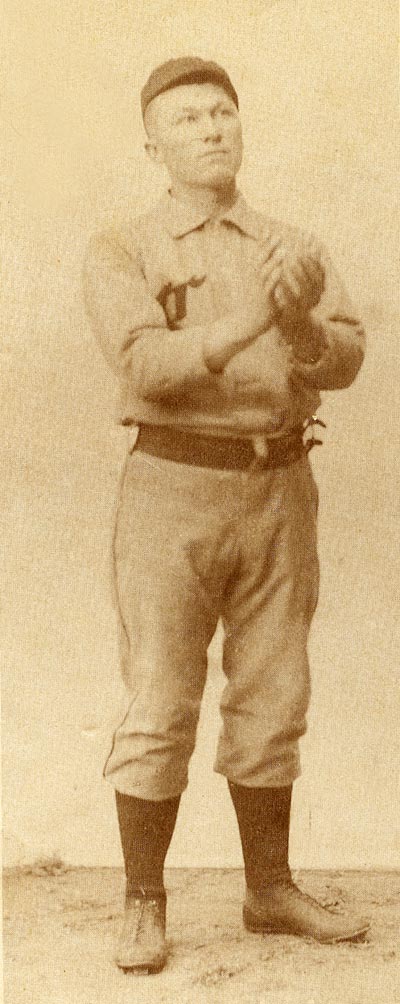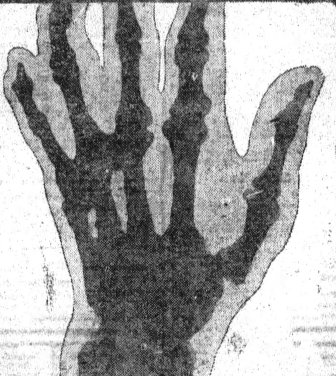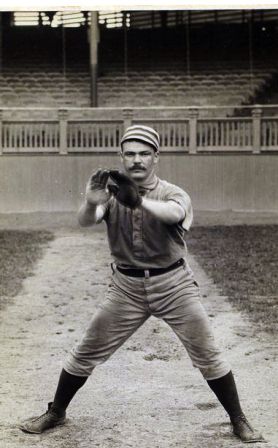Ed McKean had played 12 years in Cleveland before being part of the mass player transfer to the St. Louis Perfectos before the 1899 season. The career .302 hitter was struggling, and according to The Cleveland Plain Dealer, he requested his release:
“Ed is very sensitive to criticism, and the papers have been roasting him lately, until he got into such a nervous state that he couldn’t play ball a little bit.”
Buck Ewing said he was “forced out of the game,” and “one of the greatest shortstops the game has ever known.”
McKean’s release opened the door for Hall of Famer Bobby Wallace’s switch to shortstop.

Edward [sic Edwin] J. McKean
McKean, like his former teammate Cupid Childs had a large build, and according to the St. Louis papers needed to shed a few pounds to get back into playing shape.
The St. Louis Republic said McKean intended to spend the next several months preparing to “play in Cleveland” the following season.
McKean, said The Buffalo Courier, had a “peculiar stand at the bat,” which “often balked” pitchers
“Instead of striking the conventional side or profile position in the batman’s box. McKean gave the twirler a three-quarter view of his burly figure.”
The paper also said before becoming a ballplayer McKean had made a name for himself as a wrestler—contemporary news accounts occasionally referred to him as “Sandow,” because of his physique; a reference to Eugen Sandow the “father of modern bodybuilding”
McKean filled his time away from baseball by becoming a wrestling and boxing referee in Cleveland—if he was looking for a job that shielded him from criticism, he chose wrong. McKean served as referee for at Cleveland’s Business Men’s Gym, between Art Simms and Tommy White in December on 1899. The St. Louis Republic described the situation:
“Sandow Ed McKean, the burly grounder-copper, who secured a divorce from St. Louis on the ground of incompatibility of temperament, finds life as a referee of pugilistic encounters no less a bed of roses than playing short before a critical local crowd…Experts and common spectators asseverate that White was a winner by a mile, but Sandow fumbled the points of the game, let the strikes registered by White go over without calling them, and said it was a draw. The people yelled for a rope, and McKean thought he was again staggering at short in League Park…It was not the hated yet harmless ‘Take him out!’ that was heard, but ‘Hang the robbing rascal.’”
McKean was accused of “being in cahoots” with Simms’ manager, who the paper said was a former Boston sportswriter who McKean knew from his playing days.
White hailed from Chicago, and one of his hometown papers The Inter Ocean was even harsher in their assessment of McKean. The paper claimed:
“(White) took Mr. Art Simms in hand and administered probably the most terrific beating that had been handed out to a pretentious lightweight in recent years…(but) McKean, who used to be a fair sort of infielder, under Patsy Tebeau, called the bout a draw.”
The Chicago paper not only questioned McKean’s integrity but claimed that three of the four recent fights he had refereed “have been marked by decisions almost as ludicrous.”
Curiously, both papers failed to mention that Simms had participated in three of the four fights in question—coming away with a 2-0-1 record for the three bouts (Simms was 33-14-9 for his career and 5-0-1 in fights officiated by McKean.)
Throughout the 1900 season McKean’s imminent return was reported—usually bound for the Cleveland Lake Shores in the American League. The Sporting News said in June:
“McKean is hard at work practicing to get into the game. He goes to League Park every day, and the way that he works indicates that he is not out there for fun.”
Cleveland used six different shortstops during the 1900 season, but McKean was never signed. Published reports that he would sign with the New York Giants never materialized either.

McKean
His sitting out the entire season might have saved a life—while working at his bar The Short Stop Inn on St. Clair Avenue and Seneca (present day Third Street) in Cleveland in August of 1900, he, according to press reports, stop a potential lynching.
The Cleveland News said a news boy threw a rock at a black man, and when the man confronted the rock thrower:
“(Twenty) news boys took up the trouble. They followed the negro threatening him until he turned on them (near McKean’s saloon).”
Another confrontation took place in front of the saloon and “a volley of stones were fired at” the man who then ran into McKean’s business.
“Other newsies joined their companions until 150 boys were standing in front of the place. Their noise attracted a crowd of men and all became excited when they explained that a negro had attacked them.
“’It’s nothing but a boys fight,’ said McKean, trying to quiet the crowd. But he did not succeed. Men and boys collected stones and clubs, and the situation was becoming dangerous when McKean took the negro out the back way while employees guarded the front entrance. McKean boosted the man over the back fence and he made his escape through Noble Street.”
McKean spent all of 1901 managing his bar, working as a referee—without any further charges of crookedness—and training wrestlers; Although The Cleveland Leader reported in the spring that McKean was again working out at League Park and had “many offers from the American League.”
He finally returned to baseball in 1902, signing to manage and play first base for the Rochester Bronchos in the Eastern League.
McKean hit .314 but the club struggled all season and The Rochester Democrat and Chronicle said McKean had for some time “wanted to be released from the team” to attend to his bar. His wish was granted on August 18—with the team in sixth place with a 42-53 record, he was replaced by Hal O’Hagan—the team went 15-21 under O’Hagan.
McKean returned to his bar, managing wrestlers, and umpiring amateur games in 1903 and 1904, all the while, promising another comeback. Several newspapers reported he was either considering, or on the verge of joining various minor league clubs as manager.
He returned again in 1905. McKean signed to manage and play shortstop for the Colorado Springs Millionaires in the Western League. He struggled at the plate—hitting .191 in 22 games–and The St. Louis Post-Dispatch said his arm was gone and he was “slated for the junk pile.” Released by Colorado Springs in June, McKean appeared with seven more teams through the 1908 season: the 44-year-old called it quits for at the end of the 1908 season.
McKean refereed the occasional fight, organized semi-pro teams around Cleveland, and maintained his bar, which was the meeting place for baseball, boxing, and wrestling fans. At some point he appears to have closed his bar and gone to work for Cleveland boxing promoter
When he died in 1919, The New York Sun noted that McKean was:
“(O)ne of four big league shortstops who had a life’s average batting .300 or better. Jack Glasscock, Hughie Jennings, and Honus Wagner were the others, and it might be added that this quartet were classed as the greatest shortstops in the game.”
Tags: Art Simms, Bobby Wallace, Buck Ewing, Cleveland Spiders, Colorado Springs Millionaires, Cupid Childs, Eastern League, Ed McKean, Eugen Sandow, Hal O'Hagan, Hall of Fame, Honus Wagner, Hughie Jennings, Jack Glasscock, Rochester Bronchos, St. Louis Perfectos, Tommy White, Western League











